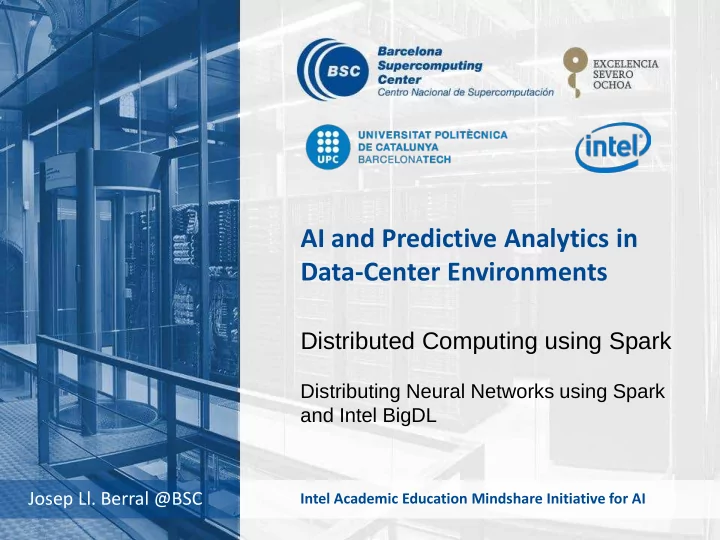

AI and Predictive Analytics in Data-Center Environments Distributed Computing using Spark Distributing Neural Networks using Spark and Intel BigDL Josep Ll. Berral @BSC Intel Academic Education Mindshare Initiative for AI
Introduction “There are solutions for distributing Deep Learning, and some optimized for leveraging specific computing architectures”
Deep Learning • Multiple Layers on Neural Networks • Model abstract patterns on data • … on different levels • … with several “stages” h1 h2 h4 h5 h3 “cat” Input Output Simpler patterns Complex patterns on image on image
Deep Learning • “How to distribute those stages?” • Do we distribute layers? • How do training adjustments communicate? h1 h2 h3 h4 h5 Input Output Data Results
Deep Learning • “How to distribute those stages?” • Do we distribute data? • How do we distribute models? • How do we aggregate models? h1 h2 h5 h3 h4 D1 Input Output h1 h2 h3 h4 h5 D2 Input Data Output h1 h2 h3 h4 h5 D3 Input Output
Deep Learning • “How to distribute those stages?” • Do we distribute …stuff? • Tensor units • FPGAs • GPUs • Accelerators h1 h2 h3 h4 h5 Data Input Output
Architecture Awareness • Platform Aware of Architecture • A platform requires High Performance • Machinery/Hardware/Components companies: • … create versions/libraries for such platforms • … optimize them for their hardware • … offer them as an optimized alternative • This is usual at Intel • E.g. Compilers • GCC (GNU multi- processor) → ICC (Optimized for Intel processors)
Intel BigDL • Tensor processing platforms • E.g. Torch • … popular platform for tensor processing • … has a common syntax for programming (+python) • … oriented to Neural Networks and Deep Learning • … can be mounted on Spark offering DL functionalities • Intel BigDL • Uses a syntax identical to Torch • … it is optimized for Intel technologies • Intel MKL (Math Kernel Library) • Multi-Threading enabled • … it is provided as Spark libraries • … tries to integrate better into Spark distribution
Intel BigDL • Shuffling Minimization • Beware of communication between workers → Minimize! D D D D ... Master Master Master D D Workers Workers Manages the Shuffling D D D D D D ... Master D D D Workers Workers Workers Direct Sharing of Data
Programming a NN • Spark + BigDL 1. Load the BigDL libraries and components If we loaded spark.ml elements, now we load bigdl elements • from bigdl.nn.layer import * 2. Define Layers E.g. a NN with 1 Hidden layer, with 5 input features, 2 output classes, and a Log SoftMax • lr_seq = Sequential() lr_seq.add(Linear(5, 2)) lr_seq.add(LogSoftMax()); 3. Define the Optimizer from bigdl.nn.criterion import * from bigdl.optim.optimizer import * optimizer = Optimizer( model = lr_seq, training_rdd = train_rdd, criterion = ClassNLLCriterion(), end_trigger = MaxEpoch(20), optim_method = SGD(learningrate=0.05), batch_size = 16)
Programming a NN • Spark + BigDL 4. Set some validation optimizer.set_validation( batch_size = 16, val_rdd = validation_rdd, trigger = EveryEpoch(), val_method = [Loss()]) 5. Then fit the model optimizer.optimize(); 6. Also perform evaluation test_results = lr_seq.evaluate( test_rdd, batch_size = 16, [Loss()])
Programming a NN Architecture Example: • from bigdl.nn.layer import * num_hidden = [10, 50, 100] num_classes = 3 ff_seq = Sequential() ff_seq.add(Linear(num_features, num_hidden[0])) ff_seq.add(ReLU()) ff_seq.add(Linear(num_hidden[0], num_hidden[1])) ff_seq.add(ReLU()) ff_seq.add(Linear(num_hidden[1], num_hidden[2])) ff_seq.add(ReLU()) ff_seq.add(Linear(num_hidden[2], num_classes)) ff_seq.add(LogSoftMax()); Corresponding to: Linear + ReLU Logit + SoftMax • h1 h2 h3 out (num_features) Class 1 Input ... ... ... Class 2 Class 3 n = 10 n = 50 n = 100
Hands-On • Next, let’s move to the Hands-On • Play with BigDL • See some NN examples
Summary • Distributing Neural Networks • Tensor processing frameworks • Intel BigDL framework • Architecture Aware and Optimization • Programming a Deep Neural Network • Training • Evaluation • Induction
Recommend
More recommend